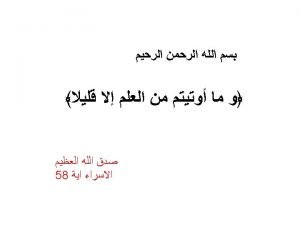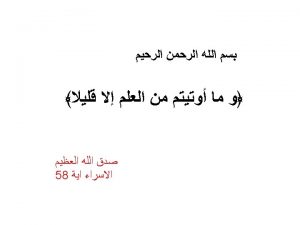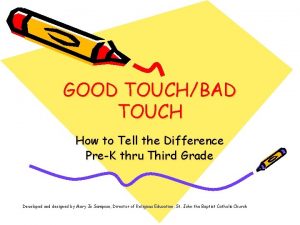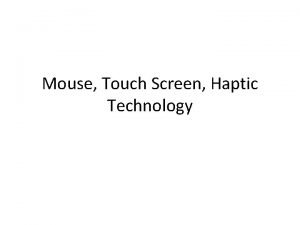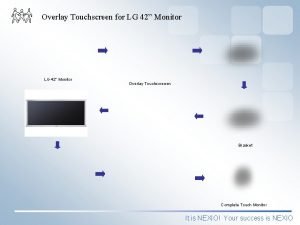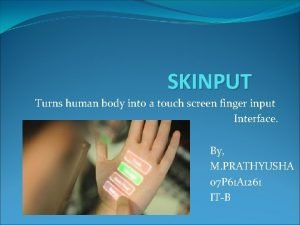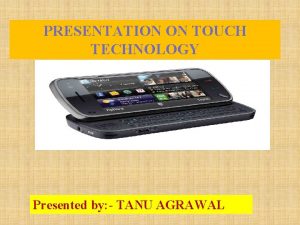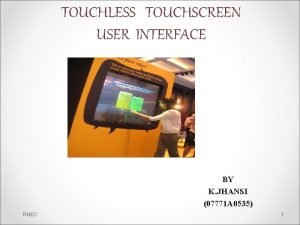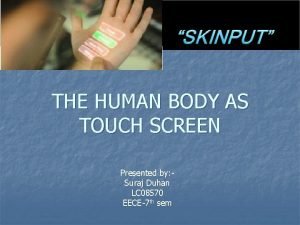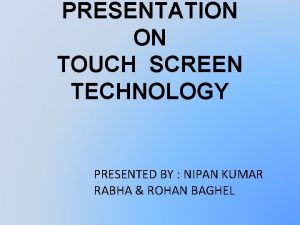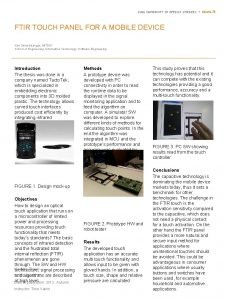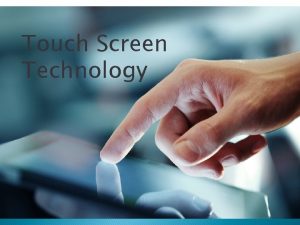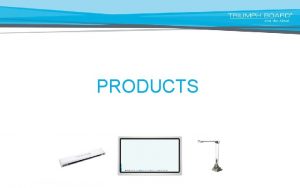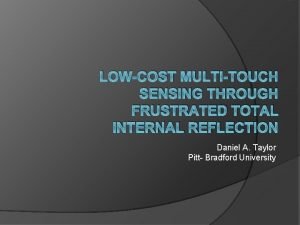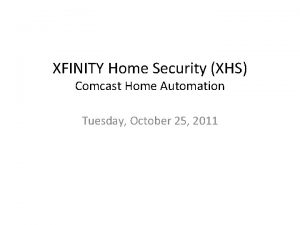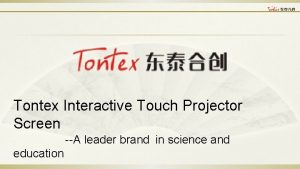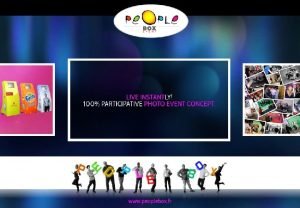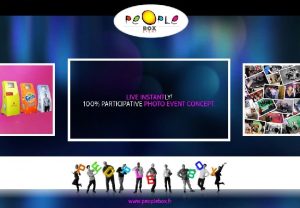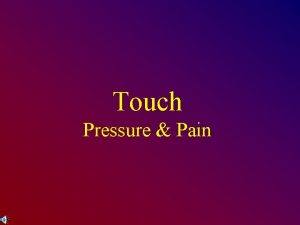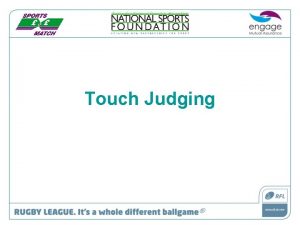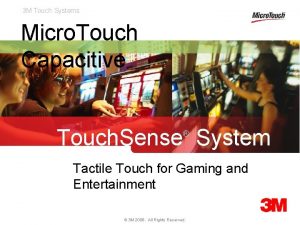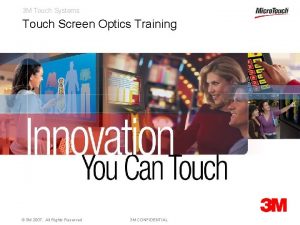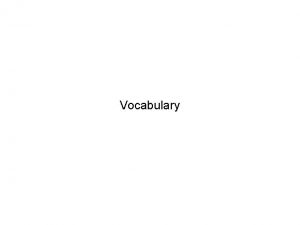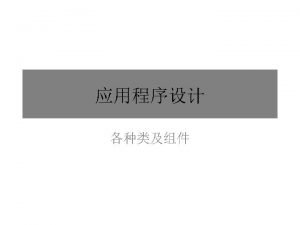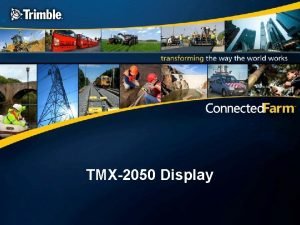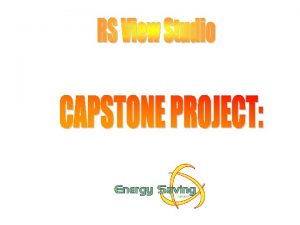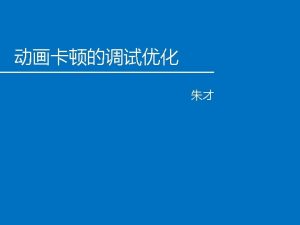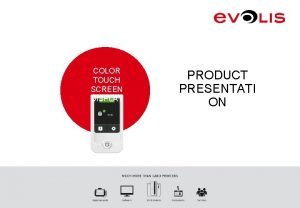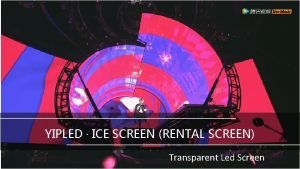What is touch screen A display screen that


















- Slides: 18


What is touch screen? A display screen that is sensitive to the touch of a finger or stylus. Touch screens are very resistant to harsh environments where keyboards might eventually fail. They are used with custom applications and on-screen buttons large enough to be pressed with the finger. Applications are typically very specialized and greatly simplified so they can be used by anyone. However, touch screens are also very popular on PDAs and full-size computers with standard applications, where a stylus is required for interaction with tiny screen objects.

History § Touch screens have become commonplace since the invention of the electronic touch interface in 1971 by Dr. Samuel C. Hurst. They have become familiar in retail settings, on point of sale systems, on ATMs and on PDAs where a stylus is sometimes used to manipulate the GUI and to enter data. § The popularity of smart phones, PDAs, portable game consoles and many types of information appliances is driving the demand for, and the acceptance of, touch screens. § The HP-150 was among one of the world's earliest commercialized touch screen computers. It actually does not have a touch screen in the strict sense, but a 9" Sony CRT surrounded by infrared transmitters and receivers which detect the position of any nontransparent object on the screen.

Applications § Only a relatively small percentage of service transactions are § § touch-enabled, almost half of respondents say they prefer touch screens over customer service agents. When asked to choose between waiting in a short line for a cashier at the supermarket and using a touch screen self checkout, 83 percent chose touch screens. Even without a line for the cashier, more than a third of the respondents (39 percent) chose touch screens. Forty-nine percent of young Americans would rather use a touch screen at a check-out kiosk in an airport than speak with an airline agent. 86 percent respondents would rather use touch screens to place orders and pay at fast food restaurants, and 70 percent would rather use touch screens to rent a car. Display manufacturers and System On Chip (SOC) manufacturers have acknowledged the trend toward acceptance of touch screens as a highly desirable user interface component , have begun to integrate touch screen functionality into the fundamental design of their products.

Current technology Dispersive Signal Technology: It uses sensors to detect the mechanical energy in the glass that occur due to a touch. Complex algorithms then interpret this information and provide the actual location of the touch. The technology claims to be unaffected by dust and other outside elements, including scratches. Since there is no need for additional elements on screen, it also claims to provide excellent optical clarity. vibrations are used to detect a touch event, any object can be used to generate these events, including fingers and styli. The technology is still quite new and is not currently widely available.

Future of touch screen § With the growing acceptance of many kinds of products with an integral touch screen interface the marginal cost of touch screen technology is routinely absorbed into the products that incorporate it and is effectively eliminated. § As typically occurs with any technology, touch screen hardware and software, has sufficiently matured and been perfected over more than three decades to the point where its reliability is unassailable. § A touch screen displays are found today in airplanes, automobiles, gaming consoles, machine control systems, appliances and handheld display devices of every kind.

Advantages Tail Design : -Touch screens have tail designs that provide greater durability and production flexibility for our customers. Tail options include integral tail, FPC tail and HSC tail designs. Reliability Touch screens undergoes the most stringent industrial standard testing, including high temperature, low temperature, high humidity, and thermal shock tests. Flexibility: - Production capabilities allow producing small quantity as well as large quantity with minimal lead time, in accordance with customers' requirements. Accuracy : - Touch screens provide high performance and greater accuracy due to precision design, production capability, and the world's best touch screen materials. Durability : -_ Touch screens are operationally tested to ten million touches for 4 - and 8 -wire touch screens; and thirty-six million touches for 5 wire touch screens.

Types of touch screen Low Reflection Touch Screen Low Reflection or sunlight readable touch screen is designed to allow readability under high ambient light including that of direct sunlight. Low Reflection touch screen utilizes special optical film to reduce and diminish reflection from light, allowing the display images a better contrast ratio and color saturation, thus achieving a high clarity image. 5 -wire resistive Low Reflection Touch Screen 5 -wire resistive touch screen with enhanced linearity in a wide range of sizes from the smallest at 5” to the largest at 21”.

High Light Transmission Touch Screen High Light Transmission touch screen enhances the optical clarity of your application, maintaining viewing sharpness. AMT touch technology solution provides you with superior optical qualities enhanced by special coatings and treatments on the touch screen heightening brightness and clarity of the displayed images. AMT's high light transmission touch screen has a visible light transmission of over 88% similar to that of single glass technology. Anti-Fingerprint Touch Screen AMT's anti-fingerprint touch screen is designed to make the surface resistant to stains, marks, smudges or any impressions from fingers, hands and other objects; as well as making these smudges less visible and easier to wipe off.

§ Resistive Touch screen Technology Resistive LCD touch screen monitors rely on a touch overlay, which is composed of a flexible top layer and a rigid bottom layer separated by insulating dots, attached to a touch screen controller. The inside surface of each of the two layers is coated with a transparent metal oxide coating (ITO) that facilitates a gradient across each layer when voltage is applied. Pressing the flexible top sheet creates electrical contact between the resistive layers, producing a switch closing in the circuit. The control electronics alternate voltage between the layers and pass the resulting X and Y touch coordinates to the touch screen controller. § 8 -Wire Resistive Technology Resistive touch screen technology exists in 4 -wire, 5 -wire, or 8 wire forms. Fast Point LCD touch screens specifically employ 8 wire resistive technology because of its benefits over its counterparts. Whereas 8 -wire Fast Point touch screens are available in all sizes.

Low Reflection Touch Screen The LCD panels today typically produce brightness (white light) of 150 -350 nits. The display ability is insufficient when exposed to direct sunlight. A luminance of greater than 600 nits is better for outdoor applications. Under this condition, the LCD panel would require a “value-added” improvement to enhance it’s luminance for outdoor applications. However, by mounting a standard resistive touch screen to the LCD, poor readability under bright lights or sunlight may occur. This is because of the reflection emitted from the standard touch screen which has a reflection rate of around 18% to 20%. low reflection touch screen design makes it simple for you without requiring you to do modifications on the existing LCD panel. This utilizes a special optical film and a polarizer film to eliminate surface reflection, increase contrast ratio and improve color saturation, achieving high clarity image and enabling readability under direct sunlight.

Linear Polarizer Touch Screen LN series: To eliminate light reflections, the touch screen is laminated with a polarizer film. Polarizer is a light isolator that allows the input light to be converted to polarized light and helps to reduce the light reflection. It is a very good cost-effective product design, especially suitable for products being used in a sunlight viewable environment.

Circular Polarizer Touch Screen CR series: It uses the linear polarizer film to convert incoming light to linear polarized light and the first layer of the 1/4λ retardant film convert this light to a circular polarized light. When this light is reflected to the second 1/4λ retardant film, it would be stopped and deflected away from the screen. In this touch screen design even when the ambient light from the external environment is very high there is a great reduction in the surrounding images that is being reflected to the viewer. After this treatment the screen image and data is easily readable for the viewer even under direct sunlight.

5 -Wire Resistive Touch Screen § 5 -Wire Resistive touch technology consists of a glass or acrylic panel that is coated with electrically conductive and resistive layers. The thin layers are separated by invisible separator dots. When operating, an electrical current moves through the screen. When pressure is applied to the screen the layers are pressed together, causing a change in the electrical current and a touch event to be registered. § 5 -Wire Resistive type touch screens are generally more durable than the similar 4 -Wire Resistive type. Although clarity is less than with other touch screen types, resistive screens are very durable and can be used in a variety of environments. This type of screen is recommended for demanding point-of-sale systems, restaurant systems, industrial controls, and other workplace applications.

Touch screen Specifications § § § Type: Elo Accu. Touch 5 -Wire Resistive Cable Interface: PC Serial/COM Port or USB Port Touch Resolution: 4096 x 4096 Response Time: 21 ms. at 9600 baud Light Transmission: 80% +/-5% at 550 nm wavelength (visible light spectrum) Expected Life: 35 million touches at one point Temperature: Operating: -10°C to 50°C Storage: -40°C to 71°C Humidity: Operating: 90% RH at max 35°C Storage: 90% RH at max 35°C for 240 Chemical Resistance: Acetone, Ethylene chloride, Methyl ketene, Isopropyl alcohol, Hexane, Turpentine, Mineral spirits, Unleaded Gasoline, Diesel Fuel, Motor Oil, Transmission Fluid, Antifreeze, Ammonia based glass cleaner, Laundry Detergents, Cleaners (Formula 409, etc. ), Vinegar, Coffee, Tea, Grease, Cooking Oil, Salt Regulations: UL, CE, TUV, FCC-B Software Drivers: Windows XP, 2000, NT, ME, 98, 95, 3. 1, DOS, Macintosh OS, Linux, Unix (3 rd Party)

Surface Acoustic Wave Touch screens § Surface Acoustic Wave technology is one of the most advanced touch screen types. It is based on sending acoustic waves across a clear glass panel with a series of transducers and reflectors. When a finger touches the screen, the waves are absorbed, causing a touch event to be detected at that point. § Because the panel is all glass there are no layers that can be worn, giving this technology the highest durability factor and also the highest clarity. This technology is recommended for public information kiosks, computer based training, or other high traffic indoor environments.

Touch screen Specifications Touch § § § Type: Elo Intelli. Touch Surface Acoustic Wave Cable Interface: PC Serial/COM Port or USB Port Touch Resolution: 4096 x 4096 Activation Force: less than 3 ounces Light Transmission: 90%Expected Life: 50 million touches at one point Temperature: Operating: -20°C to 50°C Storage: -40°C to 71°C Humidity: Operating: 90% RH at max 40°C, non-condensing Chemical Resistance: The active area of the touch screen is resistant to all chemicals that do not affect glass, such as: Acetone, Toluene, Methyl ketone, Isopropyl alcohol, Methyl alcohol, Ethyl acetate, Ammonia-based glass cleaners, Gasoline, Kerosene, Vinegar Regulations: UL, CE, TUV, FCC-Software Drivers: Windows XP, 2000, NT, ME, 98, 95, 3. 1, DOS, Macintosh OS, Linux, Unix (3 rd Party)

Reference § www. help 2 engg. com
 Tactile localization meaning
Tactile localization meaning Crude touch
Crude touch Touchbade
Touchbade When was the first touchscreen computer invented
When was the first touchscreen computer invented Touch screen alternatives
Touch screen alternatives 42 touch screen overlay
42 touch screen overlay Human being skin as touch screen
Human being skin as touch screen Touch screen is a input or output device
Touch screen is a input or output device Touch screen advantages and disadvantages
Touch screen advantages and disadvantages Touch screen technology seminar
Touch screen technology seminar Human being skin as touch screen
Human being skin as touch screen Touch screen introduction
Touch screen introduction Ftir touch screen
Ftir touch screen Touch screen technology history
Touch screen technology history Liftbox for 55 led lcd
Liftbox for 55 led lcd Frustrated total internal reflection
Frustrated total internal reflection Xfinity home overview
Xfinity home overview Touch projector screen
Touch projector screen Tôn thất thuyết là ai
Tôn thất thuyết là ai
